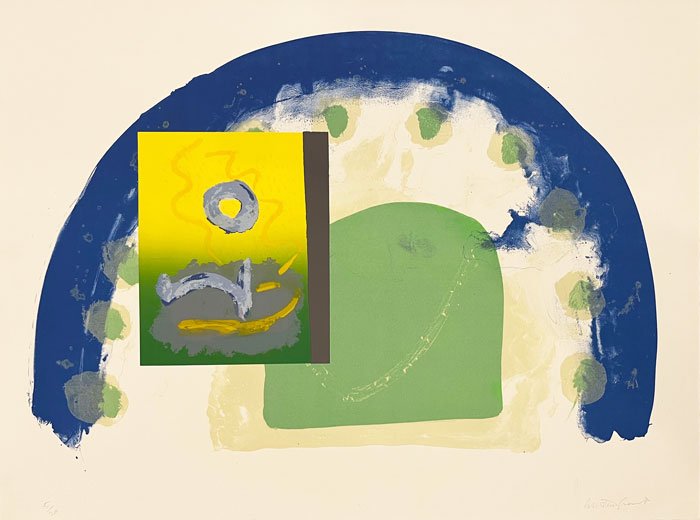Increasingly abstract | Printmaker Alistair Grant
Honfleur, Lithography & Screenprint, 57cm x 77cm, from the ' Le Touquet Suite'. Courtesy of Emma Mason British PrintsMy favourite story about the post-WW2 printmaker and teacher Alistair Grant concerns his involvement in the 1961 comedy movie The Rebel, starring Tony Hancock as talentless Modernist artist (‘Anthony Hancock’) who cons his way to stardom on the international art scene.
The beret-wearing Hancock shares a Paris studio with a younger, more traditional artist, who has genuine talent. When an art critic comes to visit, he is impressed by the younger man’s work, which he mistakenly believes to be by Hancock, who he praises to the skies in his newspaper column.
And so Hancock becomes an art star, so much so that every pretentious pronouncement and puerile piece of work he makes, however facile or inept it may be, is judged by his credulous peers and the fawning critics to be of great value, and the Infantalist School and the Shapist Movement are born. The younger artist – who remains unaware of the critic’s earlier mistake – decides that he must change his style to forge a reputation, and begins producing work that is influenced by the Modernist voice of Hancock’s pieces. Lo and behold, these works turn out to be stupendously brilliant works of art.
So who did the filmmakers – Ray Galton and Alan Simpson – turn to, to make the three, very distinct, bodies of work that drive the plot? To Alistair Grant, one of the most versatile artists of his generation, then a young teacher in printmaking at the RCA. Grant was a great believer that printmakers should also learn to paint, draw and sculpt, and that all art teachers should be practicing artists. He went on to become Head of Printing (and eventually Professor) at the college, and his department was widely considered to be the best of its type in the country.
He was also a very highly regarded artist, represented by David Zwirner Gallery (the young artist’s Modernist works in The Rebel were taken directly from a Zwirner show). Grant was true to his own philosophy, being a talented oil painter as well as a printmaker; his work became increasingly abstract as his career progressed. He pioneered the fusion of different printing methods, utilising lithograph and silkscreen, silkscreen and etching, and sometimes all three, in the same piece.
Grant’s mother was French, and he was schooled in Etaples. He kept on the family home after his parents’ death, and spent much of his time on the Normandy coast. This influenced his work – particularly in his choice of bright colours – which was viewed by critics as being something of a continental counterpart to the St Ives School. The last print he made, Fete Champetre, exhibited at the V&A’s Spirit of the Staircase show in 1996, comprised no fewer than 18 different colours.
Alistair Grant, who died in 1997, left a huge body of work behind him. His estate and archive is represented by the Eastbourne-based gallery Emma Mason British Prints, which will be exhibiting at the British Art Fair for the first time this Autumn, and showing a number of his prints and paintings. Most of the pieces Grant produced for The Rebel have disappeared, alas, so don’t expect to see any of his Hancock works, such as Ducks in Flight around the Eiffel Tower, Exhaust Fumes on a Wet Thursday Night, or Sodium Light on a Left Buttock.

